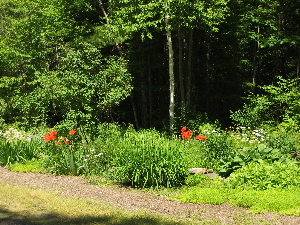NITROGEN IN THE SOIL
This weekend my son and his family were here. The two guys, my son and his 9 year old son, spent a good amount of time helping this aging grandmother in the garden doing stuff I just cannot handle any longer.
We had, over the last few seasons, had tree blow-downs, and intentional management of trees (removing them to avoid collision with the roof again!). The fellow who did the clean-up left a number of piles of wood chips for me. (I did ask him to leave the chips. Why pay for something you can get free???)
Anyway, my son spread the chips for me, and I got ready to plant the little trees I got from the local Conservation District. My problem, of course, was that the chips are NEW. That means they will suck up the nitrogen in the soil like a Hoover vacuum cleaner! They need the nitrogen in order to help them decompose. I haven't got time to wait for that, so I needed to add some nitrogen. I picked up some dried blood, which is almost total nitrogen. A little of that went into each hole with some compost. I have never done this before.
If you want to read more about the effects of nitrogen on our plants try this site from the University of Missouri Extension.
In the past, I've never used fresh wood chips, but I haven't got time to wait this time, so I had to use them. I know the little plants need the nitrogen...this is a dangerous experiment. I may lose all of the plants if the dried blood doesn't provide the nitrogen they need.
Then this morning when I was reading my NY Times on-line there was an article about nitrogen. It didn't help with my dilemma, but it was of interest to me at this moment. In case you're interested in the article, it can be found right here.




